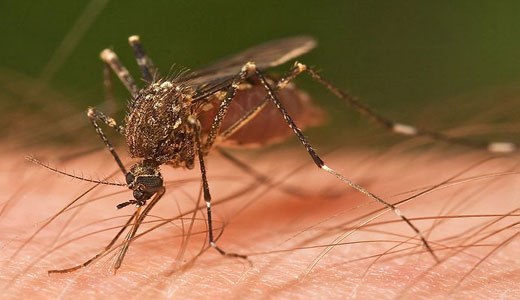
Outbreaks of the sometimes-fatal West Nile virus across the United States have intensified, making this one of the worst years ever for the mosquito-borne disease. According to experts, the virus is just one more disaster with an all too familiar culprit – global warming.
Warming weather patterns and increased rainfall in parts of the U.S. are partially responsible for the recent uptick in West Nile virus cases, and both of those conditions are expected to accelerate with climate change, scientists predicted in a 2009 report published in the journal Environmental Health Perspectives.
The disease has impacted more than 2,630 people this year, according to infectious disease expert Angela L. Rasmussen – and cases of the illness are up 35 percent this week. “The West Nile virus,” she said, “has had an overwhelming impact this year alone, particularly due to the excessive heat and humidity that has struck the United States.”
The weather has created exceptional breeding conditions for mosquitoes, allowing them to increase their numbers dramatically.
Scientists wrote, meanwhile, in Environmental Health Perspectives, “if temperature and precipitation are influential in determining West Nile virus infection risk, such dangers would likely increase the burden of this disease in coming years.”
A. Marm Kilpatrick, assistant professor in ecology and evolutionary biology at the University of California, Santa Cruz, added, “The West Nile pathogen…the warmer the temperature, the faster it moves from the blood to being transmitted. The [mosquito’s] biting rate also gets faster. So these things are going to give you more transmission.”
But because the heat also shortens the mosquito’s lifespan (which is a plus), Kilpatrick said, “it’s a little bit tricky to make a solid prediction” about how the disease will progress with climate change.
But the problem is not just limited to the West Nile virus; other diseases are getting an upgrade as well with the scorching summer conditions, including dengue and malaria. This also clearly shows that the issue is bigger than mosquitoes in the U.S. alone. Rising temperatures and rain shower increases in Asia are allowing dengue fever to spread, said regional World Health Organization director Shigeru Omi. And some cooler climates, like South Korea and Papua, New Guinea are seeing malaria-carrying mosquitoes for the first time.
Omi noted that there needs to be an increase on the part of governments in providing clean water systems, immunizations, disease surveillance programs, and a renewed focus on mosquito control and disaster preparedness. Given that Republican politicians in the U.S. are pursuing an unhealthy campaign of climate change denial, it’s anyone’s guess when those fortifications will take place in the states.
But for experts, the cause of about 118 deaths in the U.S. just this year (via the West Nile virus) is plain to see. Hot weather extends the length of the mosquito season, helps the insects reach biting age sooner, and speeds up multiplication of the virus within them, explained Vicki Kramer, chief of the California Department of Public Health’s vector-borne disease section.
Perhaps worst of all, disease is just one item on a proverbial grocery list of disastrous events linked to climate change. Wildfires, flooding, droughts, and crop and animal die-offs are just some of the events that occurred in the U.S. this year.
Climate change is “going to make controlling existing diseases harder,” said Dr. Diarmid Campbell-Lendrum, head of the climate change team at the World Health Organization’s headquarters. “We’ve been describing the links between climate change and health for quite a long time.”
Photo: JJ Harrison/Wikipedia










